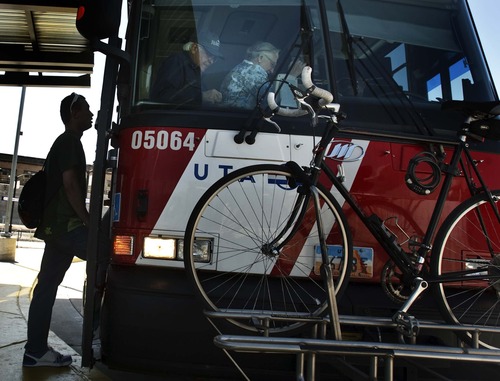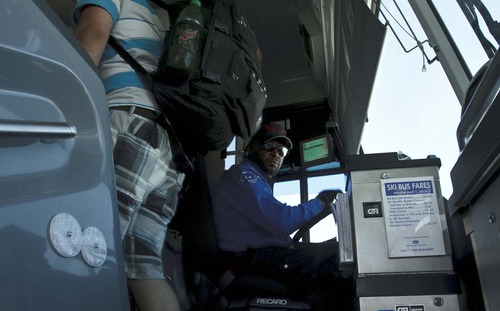This is an archived article that was published on sltrib.com in 2013, and information in the article may be outdated. It is provided only for personal research purposes and may not be reprinted.
Critics of the Utah Transit Authority have long argued that lowering fares could increase ridership so much that the move would not require more sales-tax subsidies. They may have some new evidence to bolster that argument: UTA's own data about recently lowering its fares on buses to Park City.
"We saw an increase in ridership — an average of 1,000 people a month," even though the number of trips daily between Salt Lake City and Park City were cut from 14 to 10, said Grantley Martelly, UTA regional general manager of bus support.
UTA, Park City and Summit County united to start that bus service in October 2011. After reviewing the first year of operation, they made some tweaks in fall 2012 — including lowering the fare from $5.50 a trip to $4.25 (although it rose again to $4.50 on April 1 amid systemwide fare hikes).
"We realized the fare was out of alignment with the market," Martelly said. Not only was it lowered by $1.25 a trip for the winter, but UTA also decided to allow free transfers into its TRAX and bus system for those who ride down the canyon from Park City — instead of making them pay additional fare.
Since then, ridership has been up every month, compared with the same month a year earlier. The peak was about 6,500 people a month this January, compared with a peak of about 5,900 for the same month a year earlier, Martelly said.
Lowering fares did not force an increase in taxpayer subsidies. "None of the parties [UTA, Park City and Summit County] are spending more money than they are committed to spend," Martelly said.
—
Three-way split • Agreements call for Park City and Summit County to split responsibility for a $475,000 a year subsidy, and UTA contributes another $170,00 plus providing the buses and drivers. The agreement is renewable annually, or may be canceled by any of the three.
Martelly said at current fares, the bus route must average 165 people a day in the winter season (when more trips per day are offered) to avoid increasing subsidies. It averaged about 200 a day since the changes.
Such higher ridership without increasing subsidies is what several anti-poverty and environmental-advocacy groups contended last year would happen if UTA lowered fares systemwide . Instead, previously approved increases that took effect at the beginning of this month now make UTA base fares higher than all but a handful of transit agencies nationwide.
"This new data is interesting," Bill Tibbitts, associate director of the Crossroads Urban Center, said of the Park City bus statistics.
"I would definitely encourage UTA to look at this as a model to consider elsewhere," he said. "It shows lower fares can increase ridership here. Price makes a big difference to a lot of people in deciding whether to ride."
Crossroads was one of the groups that last year called for lower fares to help the poor.
But UTA officials say lower fares aren't the only reason for the Park City line's ridership jump. Martelly said UTA shifted schedules to better meet needs of commuters, advertised the line more heavily — especially in Park City — provided promotional free-ride cards to introduce more people to the service and worked with more employers on both ends of the line to supply passes to employees.
In the peak winter season, UTA also started offering trips from a park-and-ride lot on 3900 South, because Martelly said the agency found in surveys that some seasonal commuters did not want to travel to downtown Salt Lake City first to catch buses to Park City.
—
Changes • "We did a number of things to make the service more affordable, practical and sustainable," he said. That also included reducing costs by cutting trips when few people rode. In the winter season, that move cut trips from 14 to 10 (five in each direction daily). The line also offers fewer trips in the summer season because, Martelly said, the Park City region "is like two different areas in winter versus summer."
Most of the bus riders are commuters going to work, along with a few shoppers and skiers.
While Martelly said UTA has many requests from skiers for more Park City service, "there are a lot of challenges. One is it [the current bus schedule] is too early for most skiers. We are trying to get people there to work on the ski lifts. But we have some die-hard skiers who go up and ride."
Also, the current 53-seat commuter buses are not designed to handle skis, and UTA has been unable to find ski racks that work well on them. So ski equipment must be placed in luggage compartments beneath the buses. "Most serious skiers," he said, "don't want their skis and snowboards bouncing around in a bus going up and down Parleys Canyon."
Martelly said UTA, Park City and Summit County continue to review the service and look for ways to improve it and attract more riders. He notes that current agreements call for all three to agree on any major service, fare or schedule changes.





